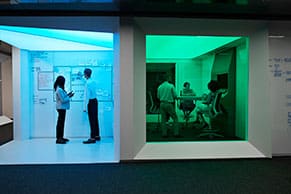What do an art gallery, a fast-growing moving business, and a specialized shipping logistics provider have in common? All three had intractable challenges that were addressed by an enterprise resource planning (ERP) system.
In all cases, their journeys started with ERP implementations. Once up and running, these disparate companies got the results they needed: increased employee productivity, faster and more accurate payroll processing, and the ability to deliver tens of thousands of orders per day without delays or errors, respectively.
What Is an ERP Implementation?
An ERP implementation is the process of installing ERP software and then making sure your team is making the most of the technology. The process includes three main phases:
Installing onsite software and/or contracting with a SaaS provider. Often, companies seek help from the vendor or an implementation partner specializing in ERP, the vertical industry, or specialized use cases.
Migrating data from your previous system or systems into the new ERP.
Training the finance team to use the new software. That process may include knowledge transfer from employees who previously used the system or formal education from your implementation partner.
The success rate of ERP implementations is improving thanks to a focus on user experience that’s led to simpler interfaces, more configuration flexibility, mobile functionality, and increased automation. In fact, IDC’s 2021 SaaSPath Survey showed that "ease of use" was the most important vendor selection criteria for those purchasing finance applications.
Best practices to ensure success include organizing a strong implementation team of leaders from all areas of your company, from sales to accounting to operations. Ask them: What problems would we like this new system to resolve?
When choosing the ERP, it’s important to ensure it can easily integrate with other key business systems, and those of your key partners, and that you can be up and running in a reasonable timeframe that could be as short as 90 days or less. Finally, make sure your finance policies and procedures are aligned to make the most of the new system.
Key Takeaways
- As part of the ERP implementation process, companies should carefully evaluate ERP vendors and/or partners, set clear expectations with realistic planning timeframes, and map out a comprehensive list of goals for the system.
- The three implementation success stories below offer practical tips on how to set up your own move to new ERP system for success.
- These case studies also highlight how this software can help businesses across all kinds of industries resolve a wide variety of challenges.
- Leaders should assess the risks of an implementation project before starting so they can minimize the impact of issues that pop up.
3 Successful ERP Implementation Case Studies
Let’s look at three companies that found success with their ERP implementation projects and key lessons we can learn from their experiences.
ERP Case Study #1: Ronin Gallery
Ronin Gallery is home to the largest collection of Japanese woodblock prints in the US and operates an art gallery in New York City as well as an online gallery. When second-generation owner David Libertson took over the business in 2013, it still managed inventory and consignments on paper and used QuickBooks for accounting.
Looking for a single system that could manage the entire business, including its ecommerce site, Ronin Gallery decided to move to NetSuite. Libertson called the NetSuite implementation team “incredible.” He especially appreciated that the implementation consultants took the time to understand the business and tailor the system to its exact needs and that they were available to provide guidance and assistance at each step in the process.
After implementing NetSuite ERP, NetSuite Inventory Management, NetSuite CRM, and NetSuite SuiteCommerce Advanced, the gallery:
- Doubled employee productivity, helping it run 50 exhibitions per year with a team of just four.
- Tracks inventory levels across multiple storage facilities in real time to prevent multiple people from purchasing the same piece of artwork.
- Manages all consignment information in one place so one employee can handle this instead of two.
- Provides exceptional service and tailored recommendations to its more than 30,000 customers with all customer data stored in the CRM.
Key Takeaways
- Ronin Gallery’s experience demonstrates the importance of an implementation team committed to gaining a strong grasp of your business and then working to build the best solution.
- The gallery’s unique business model shows that ERP systems can benefit a vast array of businesses—if you choose a flexible and adaptable system.
ERP Case Study #2: N&N Moving Supplies
N&N Moving Supplies, a family-run distributor of moving equipment and supplies, successfully implemented an ERP system after expanding from one location in Georgia to three locations in multiple states and more than quadrupling its workforce.
Running on QuickBooks and a third-party payroll provider, it was nearly impossible to keep accurate time records and reconcile payroll with general ledger accounts. So, N&N turned to ERP to manage its accounting and payroll processes. During the implementation process for NetSuite ERP, N&N worked with a NetSuite partner, NOVAtime, to add a time-clock solution to the main system.
With this in place, N&N was able to:
- Reduce payroll processing time by 84%.
- Balance accounts faster.
- Improve the accuracy of hours and vacation time counts.
- See labor-cost trends across its three locations.
- Give employees access to personalized ERP dashboards on iPads at each of its sites.
Key Takeaways
- N&N’s case study nods to another major implementation success factor: managing employee morale. ERP projects often fail when execs and other employees don’t feel a sense of buy-in. By providing personalized dashboards—and ideally explaining their benefits to employees before the implementation—N&N avoided this pitfall.
- The case study also shows that a third-party partner can be helpful in tailoring the ERP system to precisely fit your company’s needs.
ERP Case Study #3: Green Rabbit
Once upon a time, two friends launched a candy wholesale business. Then, they ran into a problem: shipping melt-prone chocolate bars during summer months. After the pals designed a heat-sensitive supply chain, other food companies turned to them for help. The duo rebranded as Green Rabbit, a supply chain logistics provider specializing in fast delivery of perishable goods.
That shift in strategy tested the company’s current processes, which relied on QuickBooks, spreadsheets, and email. Green Rabbit’s multiple databases couldn’t communicate with one another, making real-time data analysis impossible. The warehouse was often waiting on help from the IT team, too.
Green Rabbit chose NetSuite ERP, and the NetSuite professional services team got the company up and running on the system in three months.
Green Rabbit now:
- Helps customers ship candy, snacks, and more across the country in 24 hours from one of three different warehouses, without inventory errors.
- Delivers tens of thousands of orders per day, without delays.
- Gets error-free data from its ERP system instead of risking errors from manually entered data.
- Could triple its order volume, if desired, without worrying about the impact on its systems.
Key Takeaways
- When implemented correctly, ERP makes it easier to manage a complicated supply chain, as Green Rabbit’s case study shows.
- ERP is pivotal to growth. Green Rabbit implemented ERP after it grew substantially and because it anticipated further expansion.
Many growing companies like those profiled here ask: “What is the business case for ERP?” Besides the takeaways from our case studies, it boils down to agility. When finance teams stop peering at dozens of spreadsheets and paper records, they can get strategic. By helping executive and business colleagues visualize data, growing firms can forecast future trends and adapt quickly to beat competitors.
ERP Success Factors
ERP systems can revolutionize businesses and ease their paths to growth, but successful applications of them share some common traits. The first is employee adoption and morale, which requires encouraging buy-in by presenting the ERP in a way in which it will directly benefit the end users. Providing dashboards and solutions tailored to each business makes this easier to do—and tagging in a third-party partner to help with a tailored implementation is an effective way to accomplish this. Also important is planning and executing the implementation efficiently, while having realistic expectations for the timeline.
What Are the Challenges of ERP?
Implementing an ERP can mean overcoming obstacles. Two of the most commonly cited ERP challenges are:
Choosing the right vendor. Obviously, choosing an ERP system that doesn’t fit your company’s needs will likely result in a failed implementation. Many advisers recommend evaluating around five vendors before choosing the best ERP for your organization.
Companies should choose a vendor that has experience with your company’s vertical, business type (product or service), and size; can provide a hands-on demo; understands the tax laws and regulations that apply to your business; and is committed to being in this space for the long term.
Getting employees to support the change. As mentioned, teams may resist the transition to ERP if you don’t show them why the new system will be helpful to them. Explain how the system will make each team’s everyday tasks easier before the implementation begins and ensure plenty of time for training during the process.
#1 Cloud ERP
Software
Why Do ERP Implementations Fail?
ERP implementations can fail without proper risk management. In other words, leaders need to anticipate what might derail the project, then plan.
In one often-cited case, for example,(opens in a new tab) a multinational distributor’s implementation epically failed, resulting in major shipping delays and lost sales. It turns out the company had operational issues before the implementation even began, as it had just acquired another company and was having trouble integrating the new subsidiary’s operations into its own. Company leadership should have managed that risk by identifying and fixing those operational issues before the ERP implementation began.
Real Results, Real Growth: How NetSuite ERP Drives Success
ERP implementation is a process. It requires lots of planning to ensure success. However, your company isn’t the first to go through it. By considering case studies of successful implementations and choosing the right partner, your business will be set up to enjoy the benefits of the system quickly.
If you’re considering an ERP implementation, schedule a consultation with NetSuite.(opens in a new tab)









